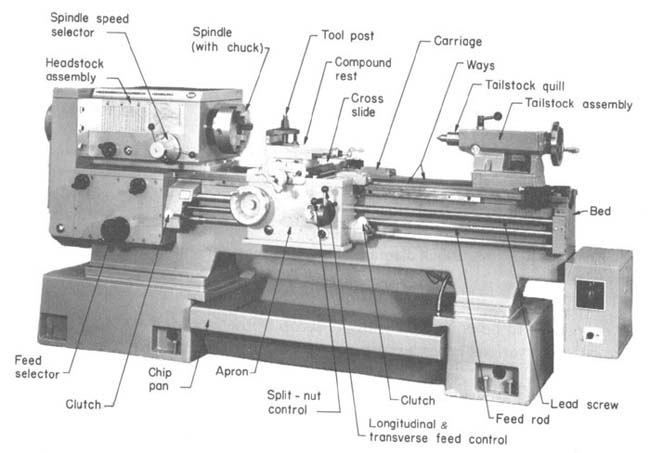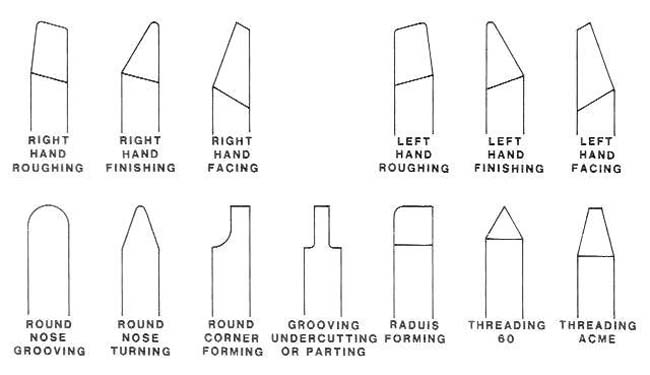Bed: Usually made of cast iron. Provides a heavy rigid frame on which all the main components are mounted.
Ways: Inner and outer guide rails that are precision machined parallel to assure accuracy of movement.
Headstock: mounted in a fixed position on the inner ways, usually at the left end. Using a chuck, it rotates the work.
Spindle: Hole through the headstock to which bar stock can be fed, which allows shafts that are up to 2 times the length between lathe centers to be worked on one end at a time.
Chuck: 3-jaw (self centering) or 4-jaw, (independent), to clamp part being machined.
Chuck: allows the mounting of difficult workpieces that are not round, square or triangular.
Tailstock: Fits on the inner ways of the bed and can slide towards the headstock to fit the length of the work piece. An optional taper turning attachment would be mounted to it.
Tailstock Quill: Has a Morse taper to hold a lathe center, drill bit or other tool.
Carriage: Moves on the outer ways. Used for mounting and moving most the cutting tools.
Cross Slide: Mounted on the traverse slide of the carriage, and uses a handwheel to feed tools into the workpiece.
Tool Post: To mount tool holders in which the cutting bits are clamped.
Compound Rest: Mounted to the cross slide, it pivots around the tool post.
Apron: Attached to the front of the carriage, it has the mechanism and controls for moving the carriage and cross slide.
Feed Rod: Has a keyway, with two reversing pinion gears, either of which can be meshed with the mating bevel gear to forward or reverse the carriage using a clutch.
Lead Screw: For cutting threads.
Split Nut: When closed around the lead screw, the carriage is driven along by direct drive without using a clutch.
Steady Rest: Clamped to the lathe ways, it uses adjustable fingers to contact the workpiece and align it. Can be used in place of tailstock or in the middle to support long or unstable parts being machined.
Follow Rest: Bolted to the lathe carriage, it uses adjustable fingers to bear against the workpiece opposite the cutting tool to prevent deflection.

Common Lathe Uses.
Facing:
Facing is the square finishing of the ends of the workpiece and is often used to bring the piece to a specified length. In facing operations, the cutter bit does not move laterally, (left or right), but cuts inward or outward from the centre of the workpiece. Facing of the ends is usually performed before turning operations to provide a `true & square` workpiece.
Straight Turning:
Straight turning may he performed upon a workpiece supported in a chuck, but the majority of workpieces turned on a lathe are turned between centers. Turning is the removal of metal from the external surface of cylindrical workpieces using various types of cutting tool bits.
Shoulder Turning:
You may need to turn a workpiece so that it will have two or more diameters in its length. For example, a bar 12 inches long might be 3 inches in diameter for half its length, and 3 1/2 inches in diameter for the other half. It would therefore have an abrupt step or shoulder 1/4 inch high that is 6 inches from the small end. The shoulder may be machined so that it forms a sharp corner with the small diameter, or a fillet may be formed so that the corner is slightly rounded instead of square.
Finish Turning:
When the workpiece has been rough turned to within about 1/32 inch of the finished size, take a finishing cut. A fine feed, the proper lubricant, and a sharp edged toolbit are necessary to produce a smooth finish. Measure carefully to be sure that the workpiece is being machined to the proper dimension. The lathe should be stopped whenever measurements are to be made.
Taper Turning:
In ordinary straight turning, the cutting tool moves along a line parallel to the axis of the work, causing the finished job to be the same diameter throughout. However, when cutting a taper, the tool moves at an angle to the axis of the work, producing a taper. Therefore, to turn a taper, the work must either be mounted in a lathe so that the axis upon which it turns is at an angle to the axis of the lathe, or cause the cutting tool to move at an angle to the axis of the lathe
Parting:
One of the methods of cutting off a piece of stock while it is held in a lathe is a process called parting. The parting tool is fed into the rotating workpiece,perpendicular to its axis, cutting a progressively deeper groove as the workpiece rotates. When the cutting edge of the tool gets to the center of the workpiece being parted, the workpiece drops off. Parting is used to cut off parts that have already been machined in the lathe, or to cut tubing and bar to their required lengths.
Boring:
Boring is a cutting operation that uses a single-point cutting tool to produce conical and cylindrical surfaces by enlarging an existing opening in a workpiece. The cutting tool moves parallel to the axis of rotation, again, boring can be straight or tapered and in order to produce a taper, the cutting tool moves at an angle to the axis of rotation..
Lathe Cutting Tools
Right handed tools cut from right to left, and therfore Left handed tools cut from left to right.
The Round nosed tool can be used in either direction.
Parting tools do not move laterally and are used for cutting into the workpiece.

